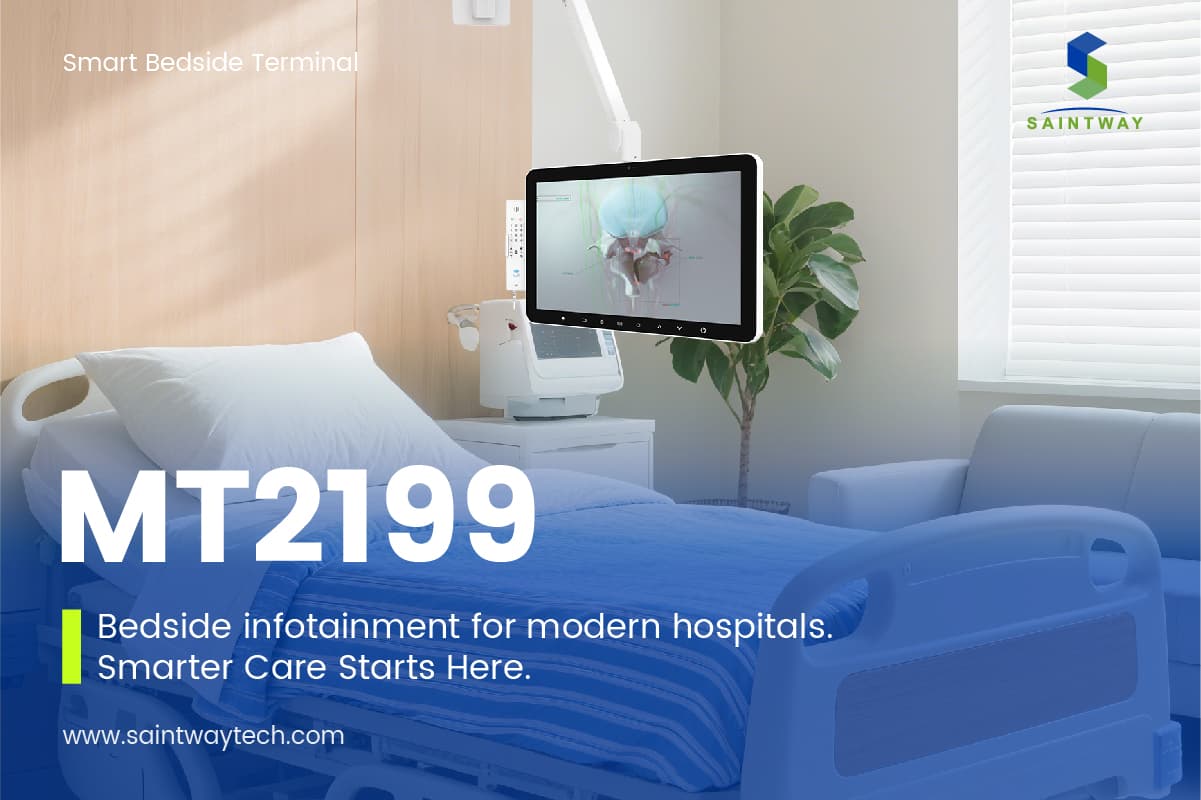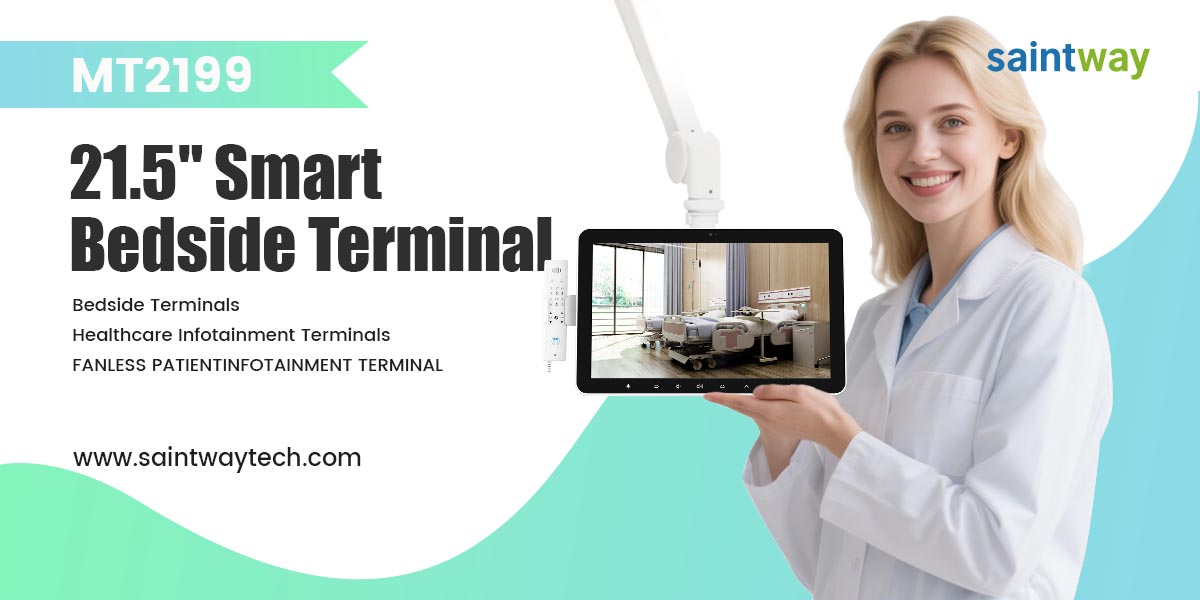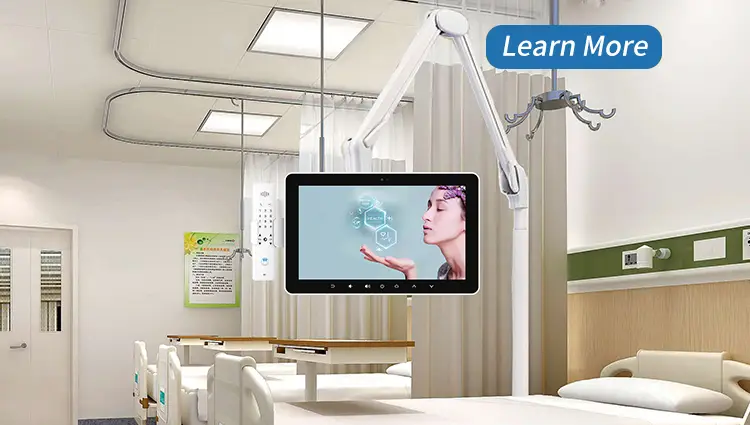As hospitals strive to create patient-centered care environments, Bedside Infotainment Terminals have emerged as an essential tool for enhancing patient experience, improving staff workflows, and delivering personalized healthcare services. These advanced systems go far beyond simple entertainment—they integrate education, communication, clinical data access, and accessibility into a single digital interface.
In this article, we’ll explore what bedside infotainment terminals are, their most valuable features, benefits for hospitals and patients, and what to expect in the future of smart healthcare environments.

What is a Bedside Infotainment Terminal?
A Bedside Infotainment Terminal is a touchscreen device mounted near a hospital bed that provides patients with access to entertainment, education, communication tools, and even clinical information. These terminals often combine a smart TV, tablet functionality, and a nurse-call interface, offering a unified platform to improve both patient engagement and staff efficiency.
Key Features of a Modern Bedside Infotainment Terminal
1. Patient Entertainment Options
Patients can access:
- Live TV
- On-demand movies
- Internet browsing
- Music streaming
- Games
This helps reduce anxiety and provides comfort during long hospital stays.
2. Patient Education & Self-Learning
Hospitals can deliver:
- Personalized care plans
- Post-op instructions
- Medication information
- Animated procedure explanations
Improved understanding leads to higher compliance and better outcomes.
3. Clinical Integration (EMR/HL7/FHIR)
Authorized hospital staff can:
- Access patient records
- View lab results
- Input vitals directly at bedside
Seamless integration improves care accuracy and staff productivity.
4. Communication Tools
Patients can:
- Call nurses via the terminal
- Schedule appointments
- Video chat with family or interpreters
- Fill satisfaction surveys
This fosters a feeling of connectivity and control.
5. Accessibility & Language Support
Terminals support:
- Multiple languages
- Voice control
- High-contrast and enlarged UI
- Screen readers for visually impaired
This ensures inclusivity for all patients.
6. Secure Login & Personalization
- RFID/NFC login for staff
- Patient-specific dashboards
- HIPAA-compliant data security
Benefits for Hospitals
✅ Improved Patient Satisfaction
Entertainment and engagement lead to higher HCAHPS scores and better public reviews.
✅ Streamlined Clinical Workflows
Less time spent on routine communication allows staff to focus on complex care needs.
✅ Reduced Readmissions
Informed patients are more likely to follow care instructions after discharge.
✅ Operational Efficiency
Digital content delivery reduces the need for paper materials and manual check-ins.
Use Cases in Modern Hospitals
- Oncology wards: Provide education about chemotherapy and symptom management.
- Pediatrics: Use games and videos to reduce anxiety in children.
- ICU/Recovery rooms: Let patients communicate with family when visitation is limited.
- Maternity wards: Offer prenatal and postnatal care content in multiple languages.
Technical Considerations
- OS Options: Most terminals run Android or Linux, offering flexibility for app integration.
- Touchscreen Sizes: Commonly 10-24 inches depending on room design.
- Mounting: VESA-compatible wall or arm mounts.
- Connectivity: Wi-Fi, Ethernet, and even 5G in next-gen models.
- Certifications: Medical-grade materials with antibacterial coatings and IP ratings.
Future Trends in Bedside Infotainment
🔮 Voice-Activated Terminals
Hands-free operation for patients with limited mobility.
🔮 AI-Powered Health Insights
Real-time recommendations based on patient vitals and recovery progress.
🔮 IoT Integration
Linking bedside devices with smart beds, wearables, and nurse stations.
🔮 Cloud-Based Systems
Enable centralized management of content, updates, and analytics.

FAQs
Q1: Can these terminals connect to a hospital’s existing EMR system?
Yes, most modern terminals support HL7 or FHIR integration, allowing secure EMR access.
Q2: Are bedside infotainment systems safe and hygienic?
Absolutely. They’re made from antimicrobial materials and designed for easy cleaning.
Q3: Can patients use these terminals in their native language?
Yes, multi-language support is a core feature of most systems.
Q4: What screen sizes are available?
Screen sizes typically range from 10” to 24”, depending on the room configuration.
Q5: Are these terminals customizable?
Yes, hospitals can brand the interface, customize the content, and define app access.
Conclusion
A Bedside Infotainment Terminal is more than a luxury—it’s a strategic tool in today’s digital healthcare environment. It empowers patients, improves clinical efficiency, and drives better outcomes. Hospitals that invest in this technology position themselves as leaders in patient-centered, tech-driven care.
Looking to enhance your patient experience? Explore our fully customizable Bedside Infotainment Terminals designed for modern hospitals. Contact us today!

